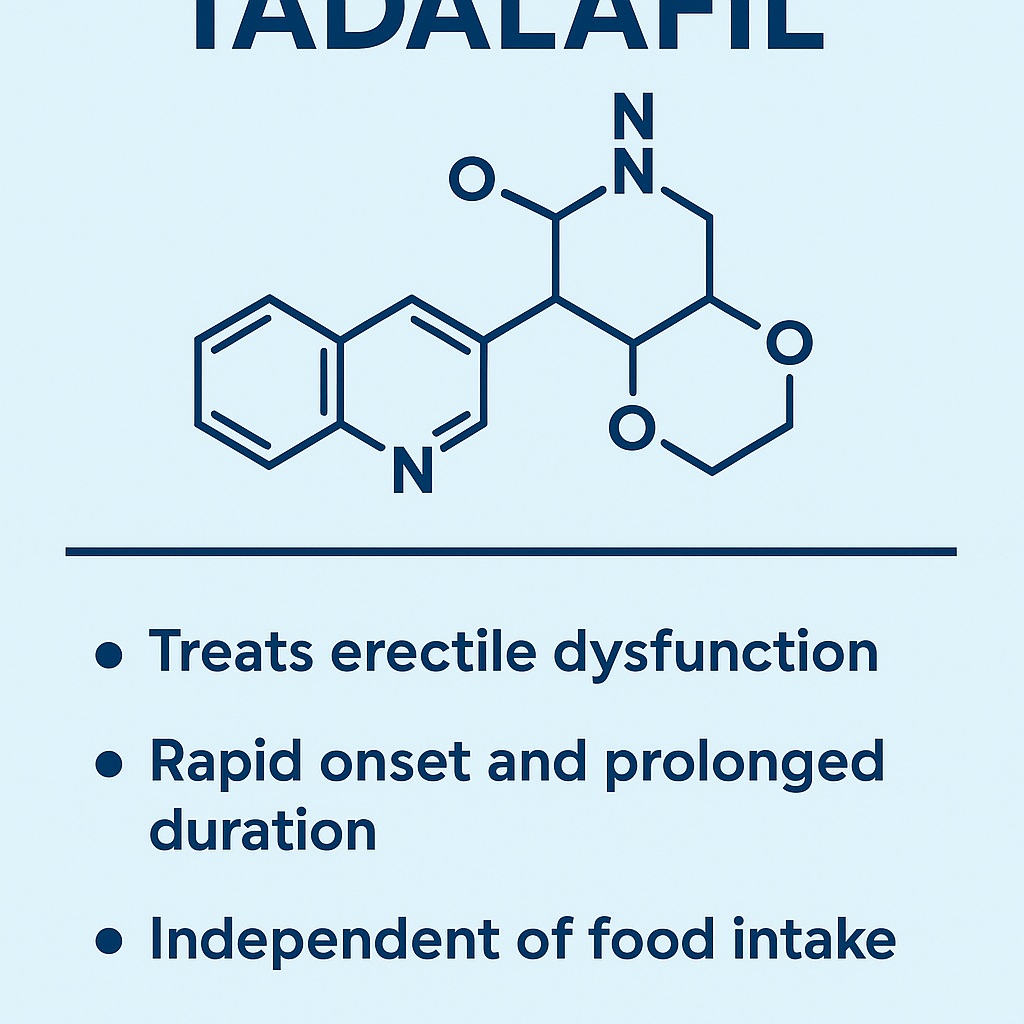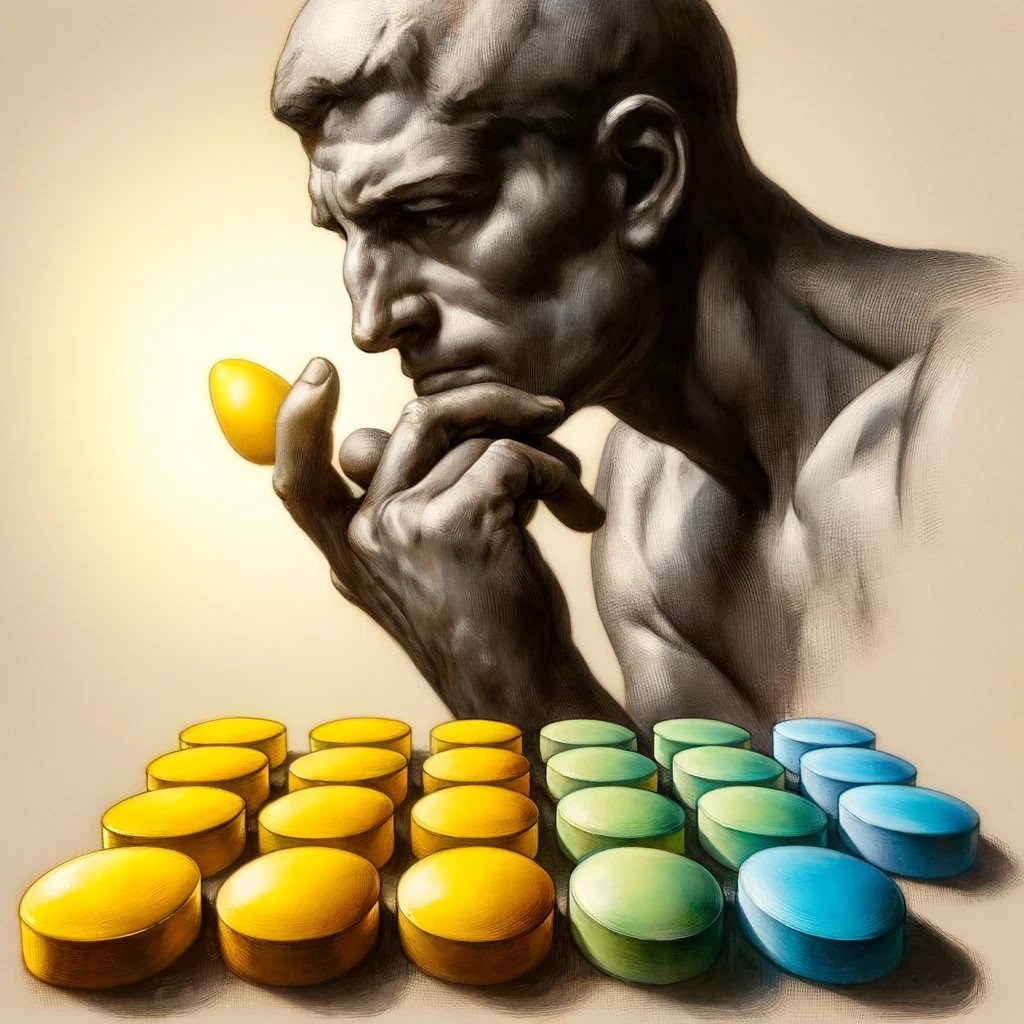
Introduction
Erectile dysfunction (ED) has long been underestimated in clinical importance, yet its burden extends well beyond the bedroom. It affects psychological well-being, quality of life, interpersonal relationships, and even long-term cardiovascular outcomes. Over the past two decades, phosphodiesterase type 5 inhibitors (PDE5is) have revolutionized therapy, shifting the perception of ED from a “silent burden” to a treatable medical condition.
However, while sildenafil and vardenafil opened the therapeutic frontier, their pharmacokinetic limitations quickly became apparent. Slow onset, the necessity of planning intercourse, and significant interference from food led to dissatisfaction, discontinuation, and diminished spontaneity. Against this backdrop, tadalafil emerged as a distinct alternative — not merely another PDE5 inhibitor, but a drug with characteristics that address the unmet needs left by its predecessors.
This article examines the pharmacological foundations of tadalafil, contrasts its profile with sildenafil and vardenafil, and highlights why it represents a uniquely patient-centered solution in ED management.
The Burden of Erectile Dysfunction
ED affects approximately half of men aged 40–70 years, with prevalence increasing steeply with age Its causes are multifactorial, encompassing vascular, neurological, endocrine, psychological, and iatrogenic factors. Importantly, ED is often the first clinical manifestation of systemic vascular disease, serving as a sentinel marker for underlying cardiovascular pathology.
The psychosocial implications are equally significant. Studies consistently demonstrate that men suffering from ED experience:
-
Reduced confidence and self-esteem
-
Higher rates of depression and anxiety
-
Strain in intimate relationships
Thus, effective ED therapy is not a mere matter of restoring sexual function — it is a holistic intervention improving life satisfaction, relationship stability, and sometimes even prognosis.
The First-Generation PDE5 Inhibitors: A Breakthrough with Limitations

The approval of sildenafil in 1998 marked a seismic shift in ED treatment. It proved, for the first time, that oral pharmacological therapy could reliably restore erectile function by selectively inhibiting PDE5, preserving cyclic GMP, and enhancing nitric oxide-mediated vasodilation.
Yet, widespread use exposed key challenges:
-
Delayed onset of action – Sildenafil and vardenafil generally require 30–60 minutes to reach therapeutic plasma concentrations, often longer after meals.
-
Food interactions – A fatty meal can delay absorption of sildenafil by up to 60 minutes, often negating the spontaneity of sexual encounters.
-
Short half-life – Sildenafil (3–5 hours) and vardenafil (4–5 hours) provide only a limited therapeutic window, restricting flexibility.
-
Adverse events – Headaches, flushing, dyspepsia, nasal congestion, and, in sildenafil’s case, visual disturbances, were common reasons for discontinuation.
These issues translated into high discontinuation rates. More than 50% of men stopped PDE5i therapy within a year, often citing dissatisfaction rather than inefficacy.
Tadalafil: A Pharmacological Outlier
Introduced in 2003, tadalafil rapidly distinguished itself from other PDE5 inhibitors. Structurally distinct, it offered a profile that addressed the shortcomings of sildenafil and vardenafil.
Key pharmacokinetic advantages include:
-
Onset of action: ~30 minutes (often clinically relevant effects within 15–20 minutes).
-
Minimal food effect: Absorption unaffected by fatty meals.
-
Exceptionally long half-life: ~17.5 hours, enabling therapeutic effects for up to 36 hours.
-
Steady-state potential: Suitable for daily low-dose regimens (2.5–5 mg), providing continuous efficacy.
These characteristics earned tadalafil the moniker “the weekend pill” — a single dose taken Friday evening could sustain efficacy until Sunday afternoon, restoring spontaneity to sexual activity.
Clinical Implications of Tadalafil’s Pharmacology
The unique half-life and pharmacokinetics of tadalafil have broad clinical implications:
1. Restoring Spontaneity
Unlike sildenafil or vardenafil, which require careful planning, tadalafil allows couples to engage in sexual activity naturally, without the constraints of dosing schedules. This reduces performance anxiety and enhances emotional intimacy.
2. Continuous Therapy
Daily low-dose tadalafil is approved not only for ED but also for benign prostatic hyperplasia (BPH). This dual indication provides symptomatic relief for urinary issues while maintaining erectile function — a therapeutic synergy particularly valuable in aging men.
3. Cardiovascular and Endothelial Benefits
Emerging data suggest tadalafil may improve endothelial function, reduce arterial stiffness, and even exert favorable effects on pulmonary arterial hypertension. Its long duration supports hypotheses of vascular conditioning beyond acute erectile response.
Comparative Analysis: Tadalafil vs. Sildenafil vs. Vardenafil
| Feature | Sildenafil | Vardenafil | Tadalafil |
|---|---|---|---|
| Onset of action | 30–60 min | 30–60 min | 20–30 min |
| Food interaction | High-fat meals delay Tmax by ~60 min | Similar to sildenafil | None |
| Half-life (t½) | 3–5 h | 4–5 h | 17.5 h |
| Duration of efficacy | Up to 6 h | Up to 8 h | Up to 36 h |
| Daily dosing option | Not standard | Not standard | 2.5–5 mg approved |
| Adverse event profile | Headache, flushing, visual changes | Headache, flushing, dizziness | Headache, back pain, myalgia |
| Best suited for | Planned intercourse | Planned intercourse | Spontaneity, frequent activity, ED with BPH |
This table illustrates that tadalafil is not merely an incremental improvement but a qualitative evolution in PDE5i therapy.
Patient Satisfaction: Beyond Rigidity to Fulfillment
Clinical studies consistently demonstrate that men value more than the mechanics of erection. Timing, reliability, and naturalness drive long-term satisfaction.
Research shows that the percentage of fully rigid erections (EHGS grade 4) strongly correlates with patient satisfaction Because tadalafil achieves consistent plasma levels and a prolonged therapeutic window, it maximizes the probability of achieving and maintaining grade 4 rigidity.
Moreover, tadalafil’s pharmacology supports the placebo effect synergy. A shorter onset and longer duration reinforce positive expectations, leading to enhanced perceived efficacy.
The Subtle Marketing Edge: Why Patients Prefer Tadalafil

From a marketing perspective, tadalafil aligns perfectly with patient priorities: discretion, naturalness, and freedom. While sildenafil may still be the entry point due to cost or familiarity, patients often migrate to tadalafil for qualitative benefits:
-
Freedom from the clock: No need to watch the minutes tick by before intercourse.
-
Confidence in any setting: Meals, social gatherings, or spontaneous encounters do not interfere.
-
Dual health benefit: Addressing urinary symptoms alongside sexual function.
Ironically, what began as a “weekend pill” evolved into a lifestyle medication, seamlessly integrating into daily routines and relationship dynamics.
Limitations and Considerations
Despite its advantages, tadalafil is not without caveats:
-
Adverse events: Myalgia and back pain, though generally mild, are more common than with sildenafil.
-
Drug interactions: Strong CYP3A4 inhibitors (e.g., ketoconazole, ritonavir) significantly increase exposure.
-
Contraindications: Use with nitrates remains an absolute contraindication due to risk of severe hypotension.
However, when weighed against its benefits, these limitations rarely outweigh the clinical advantages.
Conclusion
Tadalafil represents a paradigm shift in the treatment of erectile dysfunction. By combining rapid onset, prolonged duration, independence from food interactions, and suitability for daily dosing, it addresses the unmet needs left unresolved by sildenafil and vardenafil.
In medicine, the best therapy is not always the most powerful, but the one that aligns best with the patient’s lifestyle, expectations, and physiology. Tadalafil exemplifies this principle, making it not only a pharmacological agent but a catalyst for restored confidence, intimacy, and quality of life.
For clinicians, tadalafil should not merely be considered an alternative PDE5 inhibitor but a first-choice therapy in men prioritizing spontaneity, consistency, and overall satisfaction.
FAQ
1. How long does tadalafil really last?
Tadalafil’s half-life is about 17.5 hours, but clinical effects can persist for up to 36 hours. This does not mean an erection lasts that long, but rather that the body remains responsive to sexual stimulation within that time frame.
2. Can tadalafil be taken daily?
Yes. Daily dosing (2.5–5 mg) is approved for men who prefer continuous readiness, those engaging in frequent sexual activity, or those with concomitant benign prostatic hyperplasia (BPH).
3. Is tadalafil safer than sildenafil?
Both drugs are safe when prescribed appropriately. Tadalafil avoids visual side effects associated with sildenafil but may cause back pain or myalgia. The choice depends on individual health status, comorbidities, and lifestyle needs.
Real Tadalafil (Generic Cialis) user reviews:
William Goodking, 44 years, Corona
I was devastated when I first realized my erections were not as firm as before. I tried many products with no real success. Then I found Generic Cialis, and it completely turned things around. I feel like myself again, and my confidence has returned.
Patrick Wallbrut, 39 years, Kansas City
When I noticed my sexual stamina wasn’t what it used to be, I decided to try medications. Ordering Tadacip was the best decision I’ve made—it gave me strength, performance, and satisfaction again.
Sarah Tedlestone, 46 years, Norfolk
I was worried about my husband because our intimacy had faded. After talking openly, I found out it was an erection problem. I ordered Generic Cialis for him, and it brought back the spark in our marriage. We’re closer than ever.
Mariam Foster, 42 years, Simi Valley
My husband turned 40 and his erections became weaker. At first, I thought he lost interest, but it was simply ED. Apcalis SX helped us restore passion in our marriage, and I’m so thankful for it.
Shirley Brooks, 40 years, Glendale
We had tried different options before, but nothing worked as well as Brand Cialis. It quickly became the only product we trust. Our intimacy is back on track, and we’re both very happy.
John Summers, 39 years, Santa Monica
This was my first order from an online pharmacy, and I was nervous. Everything went smoothly—the package arrived discreetly, and Cialis Jelly exceeded my expectations. Affordable, effective, and reliable.
Peter Raybach, 42 years, St. Petersburg
Great quality and excellent service. I’ve been using Cialis Professional for over six months, and it’s never let me down. Fast delivery and outstanding results—couldn’t ask for more.
Mark James, 55 years, Birmingham
I’ve ordered Cialis Soft several times already, and each time the experience has been positive. The product works as promised, and I wouldn’t hesitate to recommend it.
Matthias Forstern, 45 years, Lund
In Sweden, prices for medications are way too high. I was relieved to discover Cialis Sublingual online—it’s affordable, and the results have been exactly what I needed.
Joseph Warder, 47 years, Leverkusen
Living in a city full of big pharmaceutical companies, I was skeptical about ordering elsewhere. But Cialis Super Active online has been a great decision—saves money and delivers quality every time.
Anthony Miles, 51 years, Houston
I had almost given up hope when I found Tadacip. It restored my confidence in ways I can’t even describe. I feel young again, and my relationship is thriving.
Carlos Mendes, 48 years, Lisbon
I’m impressed with both the service and the product. Ordering Extra Super Cialis was simple, delivery was discreet, and the results have been consistently excellent.
Greg Thompson, 41 years, Denver
I needed something that actually worked—and Tadalis SX delivered. The improvement in my performance has been remarkable, and my partner noticed immediately.
Leonard Krause, 53 years, Munich
Apcalis has given me back something I thought was gone forever. Intimacy feels natural and enjoyable again. It’s been a true game-changer for me.
References
- Zucchi A, Costantini E, Scroppo FI, Silvani M, Kopa Z, Illiano E, Petrillo MG, Cari L, Nocentini G. The first-generation phosphodiesterase 5 inhibitors and their pharmacokinetic issue. Andrology. 2019;7(6):804–817. doi:10.1111/andr.12683.
- Hatzimouratidis K, Giuliano F. Guidelines on Male Sexual Dysfunction: Erectile dysfunction and premature ejaculation. European Association of Urology. 2018.
- Chen L, Staubli SE, Schneider MP, Kessels AG, Ivic S, Bachmann LM. Phosphodiesterase 5 inhibitors for the treatment of erectile dysfunction: a trade-off network meta-analysis. Eur Urol. 2015;68(4):674–680. doi:10.1016/j.eururo.2015.01.025.
- Corona G, Rastrelli G, Burri A, Jannini EA, Maggi M. First-generation phosphodiesterase type 5 inhibitors in erectile dysfunction: A review of safety and efficacy. Andrology. 2016;4(6):1007–1019. doi:10.1111/andr.12220.
- Limoncin E, Gravina GL, Ciocca G, et al. Daily tadalafil administration improves rehabilitation after bilateral nerve-sparing radical prostatectomy. Int J Endocrinol. 2017;2017:5414087. doi:10.1155/2017/5414087.
- Montorsi F, Brock G, Lee J, et al. Effect of tadalafil on erections and quality of life of men with erectile dysfunction after radiotherapy for prostate cancer. Urology. 2004;63(5):960–965. doi:10.1016/j.urology.2004.01.002.
- Jannini EA, Droupy S. Needs and expectations of patients with erectile dysfunction: PDE5 inhibitors and beyond. Int J Clin Pract. 2019;73(11):e13396. doi:10.1111/ijcp.13396.
- Smith L, Yang L, Veronese N, Soysal P, Stubbs B, Jackson SE. Sexual activity is associated with greater enjoyment of life in older adults. Sex Med. 2019;7(1):11–18. doi:10.1016/j.esxm.2018.11.001.
- De Toni L, De Rocco Ponce M, Garolla A, et al. Pharmacokinetics and tolerability of sildenafil orodispersible film compared with conventional formulations: a randomized crossover study. Clin Drug Investig. 2018;38(4):331–339. doi:10.1007/s40261-018-0622-6.
- Cocci A, Russo GI, Briganti A, et al. Overall satisfaction and efficacy of sildenafil oral film versus sildenafil film-coated tablet in men with erectile dysfunction: results from a randomized, crossover study. Andrology. 2017;5(5):1073–1078. doi:10.1111/andr.12393.